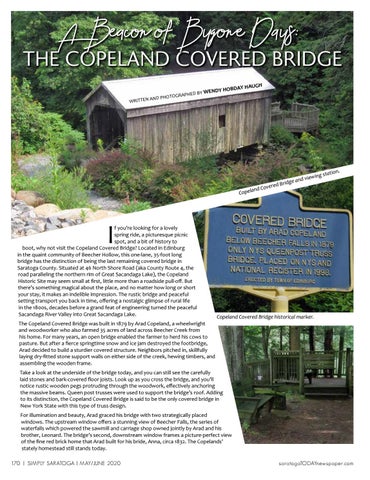A Beacon of Bygone Days:
THE COPELAND COVERED BRIDGE WRITTEN
AND PHOTO
AY HAUGH
NDY HOBD
BY WE GRAPHED
nd Copela
ed Brid
Cover
tion.
ing sta
view ge and
I
f you’re looking for a lovely spring ride, a picturesque picnic spot, and a bit of history to boot, why not visit the Copeland Covered Bridge? Located in Edinburg in the quaint community of Beecher Hollow, this one-lane, 35-foot long bridge has the distinction of being the last remaining covered bridge in Saratoga County. Situated at 46 North Shore Road (aka County Route 4, the road paralleling the northern rim of Great Sacandaga Lake), the Copeland Historic Site may seem small at first, little more than a roadside pull-off. But there’s something magical about the place, and no matter how long or short your stay, it makes an indelible impression. The rustic bridge and peaceful setting transport you back in time, offering a nostalgic glimpse of rural life in the 1800s, decades before a grand feat of engineering turned the peaceful Sacandaga River Valley into Great Sacandaga Lake. The Copeland Covered Bridge was built in 1879 by Arad Copeland, a wheelwright and woodworker who also farmed 35 acres of land across Beecher Creek from his home. For many years, an open bridge enabled the farmer to herd his cows to pasture. But after a fierce springtime snow and ice jam destroyed the footbridge, Arad decided to build a sturdier covered structure. Neighbors pitched in, skillfully laying dry-fitted stone support walls on either side of the creek, hewing timbers, and assembling the wooden frame.
Copeland Covered Bridge historical marker.
Take a look at the underside of the bridge today, and you can still see the carefully laid stones and bark-covered floor joists. Look up as you cross the bridge, and you’ll notice rustic wooden pegs protruding through the woodwork, effectively anchoring the massive beams. Queen post trusses were used to support the bridge’s roof. Adding to its distinction, the Copeland Covered Bridge is said to be the only covered bridge in New York State with this type of truss design. For illumination and beauty, Arad graced his bridge with two strategically placed windows. The upstream window offers a stunning view of Beecher Falls, the series of waterfalls which powered the sawmill and carriage shop owned jointly by Arad and his brother, Leonard. The bridge’s second, downstream window frames a picture-perfect view of the fine red brick home that Arad built for his bride, Anna, circa 1832. The Copelands’ stately homestead still stands today. 170 | SIMPLY SARATOGA | MAY/JUNE 2020
saratogaTODAYnewspaper.com








































